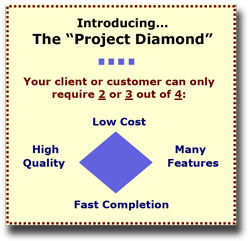Don’t Be Snared by These 6 Common Project Traps
by Adele Sommers
When your enterprise decides to undertake a new endeavor — whether it’s designing a new training program, planning a new service, or revamping an existing product — this endeavor is called a project. It involves people, budgets, resources, schedules, requirements, design, development, testing, fine tuning, and deployment, plus a host of other activities.
This article (the first of a series) explains six common traps that, when not fully recognized, can lead to unpleasant surprises. This is what I’ve observed over many years as both a project manager and a participant...
1. Each project is different in some way, shape, or form from the last one.
 If all your projects were exactly the same, you could simply use a cookie-cutter approach to crank ‘em out without losing any sleep at night. If all your projects were exactly the same, you could simply use a cookie-cutter approach to crank ‘em out without losing any sleep at night.
Although projects may share some similarities, a new project could very easily introduce several new, unfamiliar elements that can throw off your sense of balance — often without your even realizing it until it’s too late.
If those unexpected elements manage to undermine your predictions and estimates, you may find yourself in uncharted territory that involves restrategizing your entire approach.
2. Projects are often constrained by finite conditions.
Initially, you might hear limitations such as, “We only have $1,200 and three weeks to have you complete all 18 training modules for this project.” (What? You’re thinking that based on the requirements you’ve heard so far, this project should take a year and a half and cost three hundred grand!)
 Speaking of constraints, it’s not unusual for project sponsors or clients to ask for: Speaking of constraints, it’s not unusual for project sponsors or clients to ask for:
1) low cost and
2) fast completion and
3) high quality and
4) many features in the final project deliverables.
Although it’s understandable to want the greatest value for the funding, unless the project is blessed with an infinite schedule and a limitless budget, tradeoffs become necessary.
Usually it’s only possible to achieve two or three out of four of these goals on a typical project. The tradeoffs might constrain the number of features, limit the quality, or both, as shown in the Project Diamond.
3. People chronically underestimate their time and effort.
 Whether it’s because of a perceived social stigma or a cloudy crystal ball, people typically have a difficult time deriving realistic project estimates. Given the number of project unknowns, coming up with accurate predictions can be tricky. Whether it’s because of a perceived social stigma or a cloudy crystal ball, people typically have a difficult time deriving realistic project estimates. Given the number of project unknowns, coming up with accurate predictions can be tricky.
(Smart project managers know this and frequently add buffers derived from records of actual past experience to project bids, commonly known as “fudge factors.”)
To complicate matters, people often feel pressured to further “reduce the truth” — that is, to minimize whatever their already low calculations tell them it should take when they put together a bid.
Whenever management pushes people to underestimate this way — perhaps for fear of losing the project — the risks can easily overwhelm and even destroy the project’s success.
4. Project requirements are typically fuzzy at the beginning.
 Whether you’re working with your staff, your boss, your colleagues, or your clients to figure out what the project should produce, whatever they say initially may sound as clear as a bell in some areas but very sketchy in others. Whether you’re working with your staff, your boss, your colleagues, or your clients to figure out what the project should produce, whatever they say initially may sound as clear as a bell in some areas but very sketchy in others.
Getting clarification on the fuzzy parts might easily entail many conversations with many people, and much more time than anybody ever imagined. Removing that fuzziness to reach a clear, crisp agreement on what the project requirements are can prove elusive. And even if and when that occurs...
5. Requirements invariably shift over time.
 The minute after you’ve cemented the requirements with everyone’s agreement, “scope creep” begins. This means that the project needs may expand, shrink, or morph into something altogether different! The minute after you’ve cemented the requirements with everyone’s agreement, “scope creep” begins. This means that the project needs may expand, shrink, or morph into something altogether different!
These situations arise because the very act of creating something new can produce a result (or a series of results) that may exceed or differ from what people were capable of imagining at the start.
A related challenge is that even if the team initially guards against biting off more than it can chew, pressure to include “add-ons” can eventually stretch the scope beyond its limits.
6. Nearly everything else about the project is dynamic!
 Aside from the requirements changing, many other things can stop, start, or fluctuate during the project. Aside from the requirements changing, many other things can stop, start, or fluctuate during the project.
Experienced people may leave and new people may come on board. Budgets could get chopped. Schedules might get slashed or — sometimes even worse — delayed. Resources may evaporate or not materialize in the right forms. Politics can sneak in and remove support, or require skipping critical steps such as testing. The list goes on and on.
Studies of failed projects have revealed how difficult it can be to detect all of the red flags in advance. Unbridled optimism can block everyone’s ability to see clearly. Yet turning down an iffy project may be better than letting egos rule.
What to do? As we’ve seen, projects can involve several highly dynamic variables. They often operate under firm budgets and schedules. People tend to miscalculate time, effort, and resources. Requirements frequently expand, shrink, or change. And shifting circumstances can pull the rug out from under everyone’s plans. Add these together and many projects will cook up a recipe for failure.
But you and your team can learn to avoid these project pitfalls by paying close attention to the cause-and-effect relationships among these six important keys. By avoiding these common traps, you can greatly increase your project management success. Part 2 will continue the series with the next set of tips!
Copyright 2024 Adele Sommers
|


